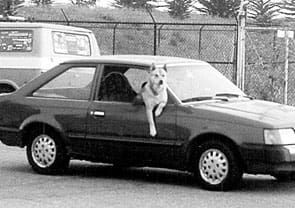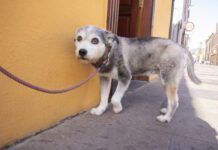I have a friend with an eight month old dog who has gotten very aggressive all of a sudden. It happens only when he is in his crate and when he is in the car, where he attacks the steering wheel and the keys. His owner was crying to me tonight about how she would have to get rid of the dog if he kept this up. He is a puppy mill dog and I don’t know if this is part of the reason for this problem.
I have given them some suggestions on social dominance but I am not sure that is the problem. They don’t allow him on the sofa or bed, and they don’t feed him table food; in fact, they eat before he eats. These are all things that have been suggested to me but I am not sure this is going to work. To me it sounds like rage syndrome.
-S.W., Indianapolis, IN
Pat Miller, WDJ’s Dog Training Editor, answers this question for us. Miller offers private and group dog training classes from her base in Fairplay, Maryland. Miller responds:
Certainly, puppy mill and other poorly-bred puppies are at a higher risk for genetically unstable temperaments. In this case, it is good that his behavior is limited to two very specific circumstances. Aggression is easier to deal with when we can identify the triggers and predict the behavior. In the crate, it could be territorial or defensive. Have the owners ever punished him in the crate? Have kids ever teased him there? In the car, it sounds like he may just be aroused about going for a ride, or it could also be territorial or possession aggression.
I tend to minimize the importance of social dominance. The dominance concept has been way overused, and tends to give people permission to use harsh punishment. I focus more on the terms leadership and deference. I restrict a dog from the bed or sofa only if a problem is occurring there. Otherwise, I simply teach the dog (using positive methods) to remove himself from those places when I ask him to leave. That is, he defers to me. When the dog is on the sofa, for example, say “off” and toss a treat on the floor. When he jumps off to get the treat, Click! your clicker (or say “yes!” in a pleasant tone of voice) and feed him another treat. Make it a fun and rewarding game, and he will happily leave the bed or sofa whenever you ask.
I see nothing wrong with feeding table scraps. The dog doesn’t know it’s people food unless you feed it to him from your plate. I prefer not to feed from my plate because I don’t want my dogs begging when I eat, but they get people food in their bowls and as training treats all the time.
I also don’t believe that eating before our dogs or going through doors first teaches them anything about dominance. Teaching them to “wait” at a door every time before you allow them to go through does teach them good manners and deference, however, as does teaching them to sit and wait for their food bowl until you release them to eat.
I would start this dog on a Nothing In Life Is Free (NILIF) program, in which he must earn all good things. He needs to learn to sit for attention or for treats, or for his ball to be thrown, or to make any good thing happen. He also needs to learn that very good things happen when he is in his crate. No punishment for his aggression you will just convince him that he is right to be upset when people approach. Have one of his owners stand near the crate and just wait until he is calm. Then Click! the clicker and feed him a treat.
As long as the Click! happens while he is calm, go ahead and feed the treat even if he gets cranky when they drop it in. Keep doing this and you should shortly see him calming down as he learns to anticipate the treat when he hears the Click! Eventually, he will also anticipate people approaching the crate because he knows good things are coming. When he is over the worst of the behavior, have the owners walk past while he is in the crate and just drop treats without clicking first until he is totally convinced that having someone approach his crate is a very wonderful thing.
I would manage the car behavior by seat belting him into the back seat, at least until the NILIF program has had a chance to take effect. If he jumps into the car and immediately takes up his position at the steering wheel, have them leash him and lead him to the back seat when they take him to the car so he can’t get to the front.
I would also suggest having them read Jean Donaldson’s wonderful book, The Culture Clash (James and Kenneth, 1996) to help them better understand whats going on in an aggressive dog’s brain, and sign them up for a basic training class with a good positive trainer so they can learn how to communicate better with their dog (and vice versa!). If the dog is not already neutered, I would do that immediately as well. It may or may not help with the behavior challenge, but it will certainly ensure that he doesn’t produce more puppies with his aggression problem.
Finally, I don’t believe that this is rage syndrome, also known as idiopathic aggression. True rage syndrome is rare, and has no definable pattern or cause. You have clearly identified the pattern and the triggers in this case. Good luck and let us know the outcome.






